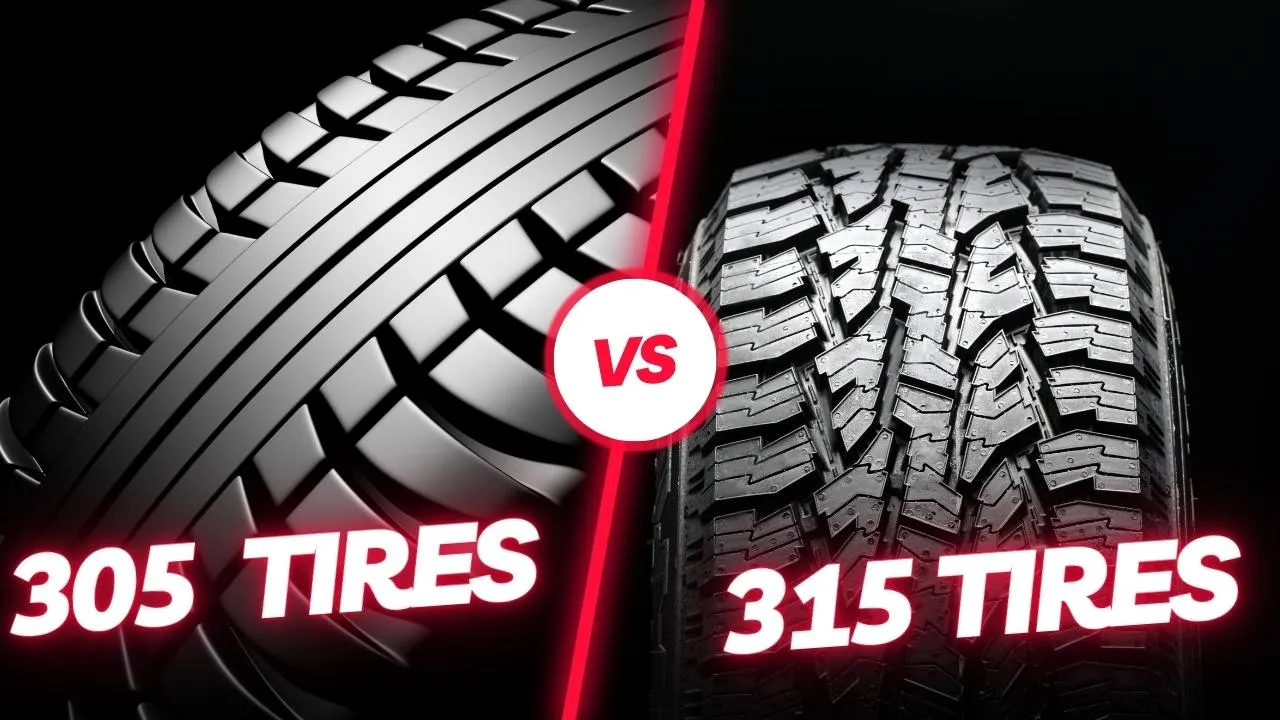In the world of tires, a mere 10 millimeters can make a world of difference. This is the case when comparing 305 and 315 tires. The primary distinction lies in their size: a 305 tire spans 305 millimeters across its width, while a 315 tire stretches slightly wider at 315 millimeters.
This small numerical difference might seem trivial, but it’s akin to the subtle yet impactful difference between two similar shades of color.
For those curious about these two tire sizes, this article dives into the heart of what sets them apart. We’ll explore how each impacts your vehicle’s performance, handling, and overall aesthetics.
Differences Between 305 and 315 Tires
When exploring the world of tires, understanding the nuances between different sizes can be pivotal. Here are the key differences between 305 and 315 tires, each offering distinct advantages and characteristics:
1. Size and Measurement
- 305 Tires: Measure 305 millimeters wide.
- 315 Tires: Measure 315 millimeters wide.
- Impact: The 10mm difference might seem small, but it’s like choosing between two backpacks with slightly different sizes; each suits different needs.
2. Performance and Handling
- 305 Tires: Offer better handling in wet conditions, as rain boots work best in the rain.
- 315 Tires: Excel in dry conditions, akin to wearing running shoes on a sunny day for better grip.
3. Cost and Fuel Efficiency
- 305 Tires: Less expensive, saving money like buying off-brand snacks that taste similar to name brands.
- 315 Tires: More costly, due to more materials used and higher shipping space needs.
- Fuel Efficiency: 305 tires are more fuel-efficient, like a light backpack making it easier to walk further without tiring.
4. Comfort and Ride Quality
- 305 Tires: Provide a smoother, more comfortable ride, similar to walking on a soft carpet.
- 315 Tires: Offer a firmer ride, which can be compared to walking on a hardwood floor.
5. Diameter and Weight
- 305 Tires: Have a smaller diameter, making them lighter (50-70 pounds).
- 315 Tires: Larger in diameter and heavier (60-70 pounds), like comparing a lightweight jacket to a heavier coat.
6. Aspect Ratio and Traction
- 305 Tires: Mostly have an aspect ratio of 70.0, offering better traction in rain, slush, and snow.
- 315 Tires: Range in aspect ratio from 35.0 to 75.0, better for dry traction and stability, like choosing different shoes for rainy or sunny weather.
Similarities Between 305 and 315 Tires
While 305 and 315 tires have their unique characteristics, they also share several important features that enhance vehicle performance and appeal:
1. Visual Appeal
They’re like stylish shoes for your car, adding a sporty and attractive look. Both tires enhance the vehicle’s appearance due to their wide profile, like how different styles of sunglasses can change a person’s look.
2. Suitable for Performance Cars
Ideal for sportier vehicles, much like running shoes are for athletes.
3. Similar Construction
Both are made with radial construction, similar to the way high-quality backpacks are built for durability.
4. Compatibility with Various Rims
They fit on a range of rim sizes (16 to 20 inches), just like how different phone cases fit various phone models.
5. Shared Speed Ratings
Both have similar speed capabilities, akin to two different brands of running shoes that can handle the same sprint speed.
Benefits of 305 Tires
The benefits of 305 tires include
1. Superior Traction in Adverse Weather Conditions
305 tires excel in challenging weather, similar to how all-terrain hiking boots grip slippery or uneven surfaces. They maintain better contact with wet or snowy roads, ensuring safer handling and reducing the risk of skidding.
2. Cost-Effectiveness and Economy
These tires are akin to finding a high-quality yet affordable option in a competitive market. They provide a balance of performance and price, making them an economical choice for drivers who want reliability without breaking the bank.
3. Fuel Efficiency and Environmental Impact
305 tires could be thought of as energy-saving devices. They require less power to roll, reducing the engine’s workload and consequently cutting down on fuel consumption. This efficiency not only saves money at the pump but also lessens the vehicle’s environmental impact.
4. Comfort and Noise Reduction
The narrower profile of 305 tires contributes to a smoother ride, akin to walking in cushioned sneakers as opposed to hard-soled shoes. They also reduce wind noise, which is particularly noticeable during high-speed highway driving, making journeys more peaceful and enjoyable.
Benefits of 315 Tires
The advantages of 315 tires are as follows:
1. Enhanced Dry Traction and Grip
315 tires offer exceptional grip on dry roads, much like specialized sports shoes that provide athletes with the necessary traction for optimum performance. This makes them suitable for various driving conditions, especially on dry pavement where they can significantly improve handling.
2. Improved Handling and Stability
With their wider contact patches, 315 tires ensure better road grip, leading to improved stability and handling. This is similar to a wide-based tripod that provides more support and balance. Whether it’s taking sharp turns or maintaining control at high speeds, these tires instill confidence.
3. Weight Distribution and Load Capacity
These tires distribute a vehicle’s weight more evenly, much like a well-balanced scale. This enhanced weight distribution leads to improved stability and increased load capacity, making the vehicle feel more planted and secure, especially under heavy loads or during dynamic driving.
4. Aesthetic Appeal and Style Considerations
315 tires add a significant visual appeal to vehicles, akin to choosing a striking accessory that elevates the overall look. Their wider profile gives a more aggressive and sporty appearance, often preferred by car enthusiasts for the bold statement they make.
Tabular Comparison Between 305 and 315 Tires
| Feature | 305 Tires | 315 Tires |
| Size and Measurement | Width: 305 millimeters | Width: 315 millimeters |
| Traction in Weather | Superior in rain, slush, and snow | Better on dry roads, adequate on wet surfaces |
| Cost-Effectiveness | Generally less expensive | More expensive due to additional material and space |
| Fuel Efficiency | Higher fuel efficiency, less environmental impact | Lower fuel efficiency compared to 305 tires |
| Comfort and Noise Reduction | Smoother ride, less wind noise | Firmer ride, potential for more wind noise |
| Handling and Stability | Good handling, especially in adverse conditions | Improved handling and stability on dry roads |
| Weight Distribution | Adequate weight distribution | Better weight distribution and load capacity |
| Load Capacity | Suitable for standard loads | Higher load capacity, ideal for heavier loads |
| Aesthetic Appeal | Attractive, less aggressive look | Sportier, more aggressive appearance |
| Dry Traction and Grip | Adequate for dry conditions | Enhanced grip and performance on dry roads |
| Wet Traction | Better performance in wet conditions | Adequate performance in wet conditions |
| Environmental Impact | Lower due to better fuel efficiency | Higher due to lower fuel efficiency |
| Ride Quality | Generally more comfortable | May be less comfortable but offers better handling |
| Visual Style | Good aesthetic appeal, but less bold | Bolder, more striking appearance |
Choosing Between 305 and 315 Tires
When deciding between 305 and 315 tires, it’s crucial to weigh various factors, from vehicle compatibility to driving conditions, much like tailoring a suit to fit your specific needs and lifestyle. This choice involves balancing practical aspects like cost and fuel efficiency with personal preferences for performance and style.
1. Vehicle Compatibility and Fitment Issues
It’s like picking the right size of clothes for your body. Ensure the tires fit your vehicle’s specifications to avoid problems like rubbing against wheel wells.
2. Impact on Fuel Consumption and Mileage
Wider 315 tires can be like carrying a heavier backpack, leading to more effort (fuel) needed to move, which might reduce your car’s mileage.
3. Cost Comparison: Initial and Long-term Expenses
315 tires are like a pricier initial investment, like buying a brand-name gadget. They cost more upfront due to material and shipping. However, consider long-term costs like fuel and tire wear.
4. Driving Conditions and Tire Suitability
Choosing between 305 and 315 tires depends on your driving needs. If you drive often in rain or snow, 305 tires are like having rain boots for better grip. If you prefer dry conditions and seek performance, 315 tires are more like sports shoes for dry tracks.
5. Style and Aesthetic Appeal
Both tire sizes can enhance your vehicle’s look, like choosing accessories to match an outfit. Wider tires add a sporty, bold style to your car.
Interchangeability and Customization
When Can You Interchange 305 and 315 Tires?
- Rim Accommodation: You can switch between 305 and 315 tires if your rims can fit the extra 10mm width. It’s like ensuring a phone case fits different phone models.
- Consultation with Experts: Before switching, it’s wise to talk to a tire expert, much like asking a chef for cooking advice. They can determine if your car suits different tire sizes.
Modifications Required for Accommodating Different Sizes
- Fitment Adjustments: Some cars might need tweaks, like adding spacers, to fit wider tires. It’s similar to adjusting a bike seat for comfort.
- Wheel Diameter Considerations: While most 305 tires fit on 16-inch rims, 315 tires need rims ranging from 16 to 20 inches, like shoes needing the right size of socks.
Practical Considerations for Interchangeability
- Vehicle Compatibility: Check if the new tire size matches your car, like choosing the right size of a backpack for a trip.
- Cost Implications: Swapping to 315 tires can be more costly initially, like buying a more expensive version of a tool. Consider long-term costs such as fuel use and tire wear.
- Driving Conditions Suitability: Choose tire sizes based on your usual driving conditions. If you drive often in bad weather, 305 tires might be better, similar to wearing rain boots in a storm.
FAQs
How Big is a 305 Tire?
A 305 tire measures about 305mm in width, roughly 12 inches, with a diameter typically around 33.21 inches. They suit rims with diameters from 16 to 20 inches.
The aspect ratio varies between 35.0 and 75.0, impacting the tire’s height, which is generally around 34 inches. The 305mm contact patch width ensures a balanced grip and is a popular choice for those seeking a blend of performance and practicality.
How Big is a 315 Tire?
With a width of approximately 315mm, translating to about 12.4 inches, 315 tires have a diameter of around 34.36 inches. These tires are compatible with 16 to 20-inch rims, offering versatility.
The aspect ratio ranges from 35.0 to 75.0, contributing to a height close to 34 inches, akin to a 35-inch model. Their robust tread design and stable radial construction make them suitable for diverse roads and activities, enhancing vehicle handling and maneuverability.
How Does Tire Size Impact Vehicle Dynamics?
Tire size significantly affects a vehicle’s performance and handling. Larger tires increase drag and moment of inertia, which can slow acceleration. They also add to the unsprung mass, impacting responsiveness.
A larger contact patch enhances grip and traction. However, bigger tires can reduce acceleration and torque due to their weight.
Can I use 305 tires in the front and 315 tires in the rear?
Yes, this setup is possible, commonly seen in performance cars for better rear traction while maintaining front-end efficiency.

